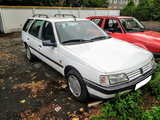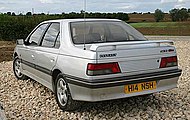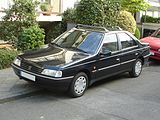Peugeot 405
| Peugeot | |
|---|---|
|
Peugeot 405 (1987-1993)
|
|
| 405 | |
| Production period: | since 1987 |
| Class : | Middle class |
| Body versions : | Limousine , station wagon |
| Engines: |
Otto engines : 1.4–2.0 liters (47–144 kW) Diesel engines : 1.8–1.9 liters (52–67 kW) |
| Length: | 4408 (4398) mm |
| Width: | 1695-1715 mm |
| Height: | 1406 (1445) mm |
| Wheelbase : | 2669 mm |
| Empty weight : | 970-1110 kg |
| Previous model | Peugeot 505 |
| successor | Peugeot 406 |
The Peugeot 405 is a mid-range vehicle from the French car brand Peugeot . It replaced the smaller Peugeot 305 , which was located between the compact and middle class, and also gradually the larger Peugeot 505, which was located in the middle and upper middle class . Until the appearance of the upper mid-range model Peugeot 605, this was offered in parallel to the 405 with higher-quality equipment and engines.
The 405 was manufactured in Europe from autumn 1987 to late summer 1995 (break: spring 1988 to autumn 1996) and is still produced as a CKD vehicle in Egypt (at Arab American Vehicles ) and in Iran (at Iran Khodro ).
The successor was the Peugeot 406 in late summer 1995 .
history
From October 1987 the vehicle was initially only available as a notchback sedan . The station wagon with the traditional addition of Break came on the market in May 1988.
As with many other Peugeot models, the body showed clear influences from the Italian coachbuilder Pininfarina . It looked very modern at the time of its appearance in the late 1980s. Outwardly, it reflected its time with the particularly good drag coefficient of around 0.3. Similar to other vehicles designed according to these aspects (such as the Audi 100 or Opel Omega ), the 405 therefore also has a high interior temperature in summer.
There was a wide range of engines, with displacements between 1.4 and 2 liters. In the beginning there were still petrol engines. The group diesels (also known from the 205) were very popular and reliable, around 300,000 km for the petrol variant and even more for the diesel equipment are not uncommon. The basic equipment started with the 405 GL with 47 kW / 64 PS and extended to the 405 SRI with 88 kW / 120 PS. The top equipment in the 405 was the Mi16 with 1.9 liters and 116 kW / 158 PS or from 1988 with cat. 108 kW / 147 PS, from 1993 then with 112 kW / 152 PS.
Between 1988 and 1991 the 405 was the last Peugeot to be offered in the USA (including the Mi16).
The 405 was also offered with all-wheel drive in the upscale equipment, namely with manual differential lock in the 405 SRI x4 and with permanent all-wheel drive in the 405 Mi16x4 . There were numerous special models, such as the Chamonix special series .
The Roland Garros version , which is only available as a Break , with green metallic paint, aluminum rims and beige leather appointments is particularly sought-after and rare . During the 1990s, improvements in safety were incorporated into production. From autumn 1993 a driver airbag could be ordered.
Facelift
In August 1993 there was a minor facelift for the 405, in which the tail lights of the sedan and the dashboard were changed and the 1.9 liter all-aluminum engines were converted to 2.0 liter cast blocks.
In September 1995, the production of the sedan was stopped because the successor Peugeot 406 was already in the starting blocks. The Break station wagon version was offered until September 1996.
The Peugeot 405 is becoming increasingly rare in Germany. Many vehicles migrate to Eastern Europe because of their durable diesel engine. In France, the 405 is still part of the street scene because of its very high distribution. Occasionally it can even be seen as a gendarmerie vehicle. The Peugeot 405 was also used as a patrol car in Saarland, both as a limousine and as a break.
405 Turbo 16
The peak performance in 1992 was the 405 Turbo 16 ( 405 T16 ), which was equipped with a 2-liter 16V XU10J4TE turbo engine. This has a Garrett loader (VAT 25) with adjustable geometry. In addition, it has a water-cooled intercooler and sequential Magneti-Marelli AP injection. The 2.0-liter engine developed 144 kW (196 hp) and for a short time even 162 kW (220 hp). This is made possible by the turbo overboost , which briefly increases the boost pressure to 1.3 bar.
In addition to the standard leather-Alcantara equipment and immobilizer, it has permanent all-wheel drive with a hydraulically sprung rear axle with Torsen differential and a transfer case with viscous lock.
The car had a new price of 60,000 DM. 1046 units were built, 46 of which went to the gendarmerie. Only 99 copies were delivered to Germany.
Motorsport
In racing, a 405 Turbo 16 was used as a coupé. This vehicle had all-wheel drive and a mid-engine that produced 294 kW (400 hp). With this, Peugeot took part in the Paris-Dakar rally from 1987 to 1990, and in 1988 at Pikes Peak with an upgrade to 441 kW (600 hp).
After Group B was banned in the mid-1980s, Peugeot used its rally experience in the Paris – Dakar desert rally and on Pikes Peak . The models 205 Turbo 16 and 405 Turbo 16 took part in these events .
The racing version of the Peugeot 405 Turbo 16 is based on the all-wheel turbo technology of the 205 Turbo 16. Like this one, it had permanent all-wheel drive and the XU8T engine. This engine has been specially developed for racing. It is placed as a mid-engine on the right side of the vehicle and has a displacement of 1775 cm³, which corresponds to a virtual displacement of 2500 cm³ due to the turbo factor 1.4. The water-cooled turbocharger from the manufacturer Garrett, which was also used in this size in Formula 1 at the time, charges the engine with up to 2.8 bar boost pressure. This engine has an output of 294 kW (400 hp) on the Paris Dakar and 441 kW (600 hp) on the Pikes Peak. The manual six - speed gearbox sits next to the engine on the left . The wheels are individually suspended at the front and rear on triangular wishbones at the top and bottom. The suspension consists of coil springs and coaxial telescopic shock absorbers. Internally ventilated disc brakes are installed at the front and rear . The weight of the Pikes Peak version was 800 kg. Thanks to its good power-to-weight ratio , the 405 T16 needs around 8 seconds on asphalt to accelerate from 0 to 210 km / h.
The Paris-Dakar rally was won by Peugeot from 1987 to 1990. The first time the 405 took part in the Paris-Dakar, Ari Vatanen's car was stolen. He was then disqualified for delayed starts after the car was found. In 1988 the time had come when Walter Röhrl's track record on Pikes Peak was to be broken. Ari Vatanen already undercut the times of the Audi driver who dominated last year in training . On the day of the race, Vatanen had already shelved the record, as it was raining heavily on the first kilometers up the mountain, but it was still supposed to undercut the lap time set by Röhrl in the Audi Sport quattro E2 .
Trivia
In the Wolfsland series , the main character Burkhard “Butsch” Schulz, played by Götz Schubert , drives a silver-gray Peugeot 405.
Engines
Web links
- Picture of a 405 T16 during the Pikes Peak Hill Climb ( Memento from March 22, 2007 in the Internet Archive )
Individual evidence
- ^ Jan Kretzmann: Iranian cheap cars for Europe. Sheet metal from the Orient. Report on autobild.de from March 10, 2009.
- ↑ PSA-Peugeot-Citroen.com: 2009 Sustainable Development Performance Indicators
| Timeline of the Peugeot models since 1945 | ||||||||||||||||||||||||||||||||||||||||||||||||||||||||||||||||||||||||||||
|---|---|---|---|---|---|---|---|---|---|---|---|---|---|---|---|---|---|---|---|---|---|---|---|---|---|---|---|---|---|---|---|---|---|---|---|---|---|---|---|---|---|---|---|---|---|---|---|---|---|---|---|---|---|---|---|---|---|---|---|---|---|---|---|---|---|---|---|---|---|---|---|---|---|---|---|---|
| Type | 40s | 50s | 60s | 70s | 80s | 90s | 2000s | 2010s | 2020s | |||||||||||||||||||||||||||||||||||||||||||||||||||||||||||||||||||
| 5 | 6th | 7th | 8th | 9 | 0 | 1 | 2 | 3 | 4th | 5 | 6th | 7th | 8th | 9 | 0 | 1 | 2 | 3 | 4th | 5 | 6th | 7th | 8th | 9 | 0 | 1 | 2 | 3 | 4th | 5 | 6th | 7th | 8th | 9 | 0 | 1 | 2 | 3 | 4th | 5 | 6th | 7th | 8th | 9 | 0 | 1 | 2 | 3 | 4th | 5 | 6th | 7th | 8th | 9 | 0 | 1 | 2 | 3 | 4th | 5 | 6th | 7th | 8th | 9 | 0 | 1 | 2 | 3 | 4th | 5 | 6th | 7th | 8th | 9 | 0 | |
| Microcar | ion | |||||||||||||||||||||||||||||||||||||||||||||||||||||||||||||||||||||||||||
| 106 | 107 | 108 | ||||||||||||||||||||||||||||||||||||||||||||||||||||||||||||||||||||||||||
| Small car | 104 | 205 | 206 | |||||||||||||||||||||||||||||||||||||||||||||||||||||||||||||||||||||||||
| 202 | 207 | 208 I. | 208 II | |||||||||||||||||||||||||||||||||||||||||||||||||||||||||||||||||||||||||
| Compact class | 204 | 301 | ||||||||||||||||||||||||||||||||||||||||||||||||||||||||||||||||||||||||||
| 203 | 304 | 305 | 306 | 307 | 308 I. | 308 II | ||||||||||||||||||||||||||||||||||||||||||||||||||||||||||||||||||||||
| Lower middle class | 309 | 408 I. | 408 II | |||||||||||||||||||||||||||||||||||||||||||||||||||||||||||||||||||||||||
| Middle class | 403 | 404 | 405 | 406 | 407 | |||||||||||||||||||||||||||||||||||||||||||||||||||||||||||||||||||||||
| 505 | 508 I. | 508 II | ||||||||||||||||||||||||||||||||||||||||||||||||||||||||||||||||||||||||||
| upper middle class | 504 | |||||||||||||||||||||||||||||||||||||||||||||||||||||||||||||||||||||||||||
| 604 | 605 | 607 | ||||||||||||||||||||||||||||||||||||||||||||||||||||||||||||||||||||||||||
| Coupe | RCZ | |||||||||||||||||||||||||||||||||||||||||||||||||||||||||||||||||||||||||||
| 404 coupe | 504 coupe | 406 coupe | 407 coupe | |||||||||||||||||||||||||||||||||||||||||||||||||||||||||||||||||||||||||
| Minivan | 1007 | |||||||||||||||||||||||||||||||||||||||||||||||||||||||||||||||||||||||||||
| Crossover | 2008 I. | 2008 II | ||||||||||||||||||||||||||||||||||||||||||||||||||||||||||||||||||||||||||
| 3008 I. | ||||||||||||||||||||||||||||||||||||||||||||||||||||||||||||||||||||||||||||
| SUV | 3008 II | |||||||||||||||||||||||||||||||||||||||||||||||||||||||||||||||||||||||||||
| 4008 | ||||||||||||||||||||||||||||||||||||||||||||||||||||||||||||||||||||||||||||
| 4007 | ||||||||||||||||||||||||||||||||||||||||||||||||||||||||||||||||||||||||||||
| 5008 II | ||||||||||||||||||||||||||||||||||||||||||||||||||||||||||||||||||||||||||||
| Compact van | 5008 I. | |||||||||||||||||||||||||||||||||||||||||||||||||||||||||||||||||||||||||||
| Van | 806 | 807 | ||||||||||||||||||||||||||||||||||||||||||||||||||||||||||||||||||||||||||
| Off-road vehicle | P4 | |||||||||||||||||||||||||||||||||||||||||||||||||||||||||||||||||||||||||||
| Pick up | 403 truck | 404 pick up | 504 pick up | Pick up | Land trek | |||||||||||||||||||||||||||||||||||||||||||||||||||||||||||||||||||||||
| High roof combination | Traveler | |||||||||||||||||||||||||||||||||||||||||||||||||||||||||||||||||||||||||||
| Box van | 205 Multi / Fourgonnette | |||||||||||||||||||||||||||||||||||||||||||||||||||||||||||||||||||||||||||
| Bipper | ||||||||||||||||||||||||||||||||||||||||||||||||||||||||||||||||||||||||||||
| partner | partner | Rifter | ||||||||||||||||||||||||||||||||||||||||||||||||||||||||||||||||||||||||||
| Transporter | D3 | D4 | J7 | J9 | Expert | Expert | Expert | |||||||||||||||||||||||||||||||||||||||||||||||||||||||||||||||||||||
| J5 | boxer | boxer | ||||||||||||||||||||||||||||||||||||||||||||||||||||||||||||||||||||||||||
|
|
||||||||||||||||||||||||||||||||||||||||||||||||||||||||||||||||||||||||||||
| Timeline of the Peugeot models from 1889 to 1944 | ||||||||||||||||||||||||||||||||||||||||||||||||||||||||
|---|---|---|---|---|---|---|---|---|---|---|---|---|---|---|---|---|---|---|---|---|---|---|---|---|---|---|---|---|---|---|---|---|---|---|---|---|---|---|---|---|---|---|---|---|---|---|---|---|---|---|---|---|---|---|---|---|
| Type | 1880s | 1890s | 1900s | 1910s | 1920s | 1930s | 1940s | |||||||||||||||||||||||||||||||||||||||||||||||||
| 9 | 0 | 1 | 2 | 3 | 4th | 5 | 6th | 7th | 8th | 9 | 0 | 1 | 2 | 3 | 4th | 5 | 6th | 7th | 8th | 9 | 0 | 1 | 2 | 3 | 4th | 5 | 6th | 7th | 8th | 9 | 0 | 1 | 2 | 3 | 4th | 5 | 6th | 7th | 8th | 9 | 0 | 1 | 2 | 3 | 4th | 5 | 6th | 7th | 8th | 9 | 0 | 1 | 2 | 3 | 4th | |
| Small car | 1 | 2 | 3 / 4 | 5 / 6 / 7 / 8 | 21 / 24 / 30 / 31 | 37 | 54 | 57 | 69 "Bébé" | B P1 / B3 / P1 "Bébé" [1] | 161/172 "Quadrilette" | 190 | ||||||||||||||||||||||||||||||||||||||||||||
| 26 / 27 / 28 | 48 | 126 | 201 | 202 ... | ||||||||||||||||||||||||||||||||||||||||||||||||||||
| Compact class | 14 / 15 / 25 | 56 | 58 | 68 | VA / VC / VY [1] | V2C / V2Y [1] | VD / VD2 [1] | 159 | 163/163 BS | 301 | 302 | |||||||||||||||||||||||||||||||||||||||||||||
| 33 / 36 | 63 | 99 | 108 | 118 | 125 | 173 / 177 / 181 / 183 | ||||||||||||||||||||||||||||||||||||||||||||||||||
| Middle class | 9 / 10 / 11 / 12 | 16 / 17 / 19 / 32 | 49/50 | 65/67 | 77 | 78 | 88 | 127 | 143 | 153 | 153 B / BR | 176 | 401 | 402 | ||||||||||||||||||||||||||||||||||||||||||
| 18th | 39 | 61 | 71 | 81 | 96 | 106 | 116 | 126 | 138 | 175 | ||||||||||||||||||||||||||||||||||||||||||||||
| upper middle class | 23 | 42/43/44 | 62 | 72 | 82 | 92 | 104 | 112/117/122/130/134 | 139 | 145/146/148 | 174 / 184 | 601 | ||||||||||||||||||||||||||||||||||||||||||||
| 66 | 76 | 83 | 93 | 135 | 156 | |||||||||||||||||||||||||||||||||||||||||||||||||||
| Upper class | 80 | 103 | 113 | 141 | 147/150 | |||||||||||||||||||||||||||||||||||||||||||||||||||
| 85 | 95 | 105 | ||||||||||||||||||||||||||||||||||||||||||||||||||||||
| Convertible / Spider | 91 | 101/120 | 133 / 111/129/131 | 136 | 144 | |||||||||||||||||||||||||||||||||||||||||||||||||||
| Box van | 13 | 22nd | 34/35 | |||||||||||||||||||||||||||||||||||||||||||||||||||||
| minibus | 20 / 29 | 107 | ||||||||||||||||||||||||||||||||||||||||||||||||||||||







